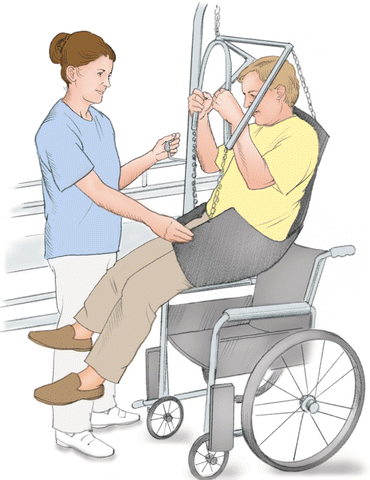Managing the intensity and duration of pressure is key to preventing pressure injuries, especially for patients with limited mobility. Other prevention strategies include reducing friction and shear, minimizing moisture, maximizing nutritional status, and controlling chronic illnesses that contribute to pressure injury development (such as diabetes). Recently, select foam dressings have been used over bony prominences in high-risk patients to prevent pressure injuries. Regular skin assessment and pressure injury risk assessment are a vital part of the prevention plan. Remember that changes in darkly pigmented skin may not be easily visible, so these patients need especially careful assessment. Notice the differences in the stage 1 pictures between the person with light vs dark complexion.

Positioning patients
All at-risk patients should have an individualized repositioning plan when in bed or chair. Even patients on a specialized support surface, or those patients with continuous lateral rotation therapy (CLRT) for respiratory issues, need to be repositioned. To position a reclining patient and turning the patient 30 degrees, use the Rule of 30 (raising the head of the bed 30 degrees, as shown below). Raising the head more than 30 degrees can cause shearing pressure. When you must raise it more (such as at mealtimes), keep the periods brief.

When repositioning a patient from the left side to the right, make sure the weight rests on the buttock, not the hip bone. This reduces pressure on the trochanter and sacrum. The angle between the bed and an imaginary lateral line through the hips should be about 30 degrees (as shown here).
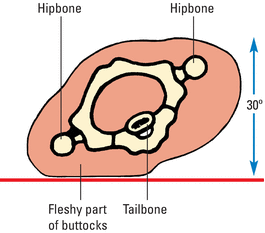
If needed, use pillows or a foam wedge to help the patient maintain the proper position. Cushion pressure points, such as the knees and shoulders, with pillows. Consider using a patient monitoring position system to assist in maintaining an appropriate turning schedule and 25- to 30-degree turn angle.

Comparing support surface characteristics
Support surfaces are specialized devices for pressure redistribution that distribute load over the contact areas of the body. They work by managing tissue load and microclimate. Check specific product information to determine what is the best for the individualized patient's needs. And don't forget the chair cushion!
Important points:
- Consider your patient's weight and the weight limitations of the surface
- Many surfaces are contraindicated with unstable cervical, thoracic, or lumbar spine
- Consider fall risk and bed height if the patient is restless, combative or agitated
Patients with multiple stage 2, large or multiple stage 3 or 4 pressure injuries on trunk and pelvis involving more than one turning surface should have low air loss or air-fluidized therapy.

Braden mobility subscale scores
|
CLP = constant low pressure; LAL = low air loss; AP = alternating pressure; AF = air fluidized; AMG = Australian medical grade.
Reactive = provides pressure redistribution in response to an applied load (patient) by immersion and envelopment, powered or nonpowered
Active = powered surface that can change load redistribution with or without applied load (patient)
McNichol, L., Watts, C., Mackey, D., Beitz, J., & Gray, M. (2015). Identifying the right surface for the right patient at the right time: Generation and content validation of an algorithm for support surface selection. Journal of Wound, Ostomy, and Continence Nursing, 42(1), 19–37.
The fluid-like surface of an air-fluidized therapy bed redistributes pressure on the skin by forcing air through beads. It conforms to the body as the patient sinks into the surface. It helps prevent pressure injuries and promote wound healing. The bed also provides the advantages of flotation without the disadvantages of instability, patient positioning difficulties, and immobility.
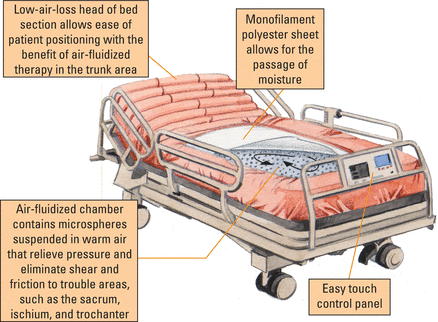
Low air loss therapy beds contain segmented air cushions that inflate to help redistribute pressure on skin surfaces and to minimize shearing force during repositioning. The beds also help manage heat and humidity (microclimate) of the skin. This option can be an integrated bed system or a specialized mattress overlay that fits on regular hospital bed frames.

An alternating pressure mattress redistributes pressure using cyclic changes that create alternating low- and high-pressure areas.


Reactive/constant low-pressure (CLP) surface
A nonpowered or powered mattress or overlay support surface that redistributes pressure in response to the person's body weight by immersion and envelopment. This includes foam, gel, fiber, viscous fluid, static air or water, or bead-filled mattress.
Using a hydraulic lift
Using a hydraulic lift to transfer an immobile or obese patient reduces the effects of shear and friction on the skin—a key strategy of pressure injury prevention. It is also safer for the caregivers. These general guidelines will help you to transfer your patient safely and comfortably. Be sure to follow the manufacturer's instructions.
- After placing the patient in a supine position in the center of the sling, position the hydraulic lift above the patient (as shown below). Then attach the chains to the hooks on the sling.
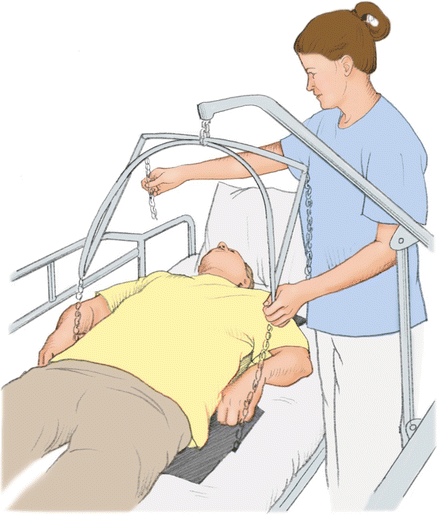
- Turn the lift handle clockwise to raise the patient to the sitting position. If the patient's positioned properly, continue to raise until the patient's suspended just above the bed.
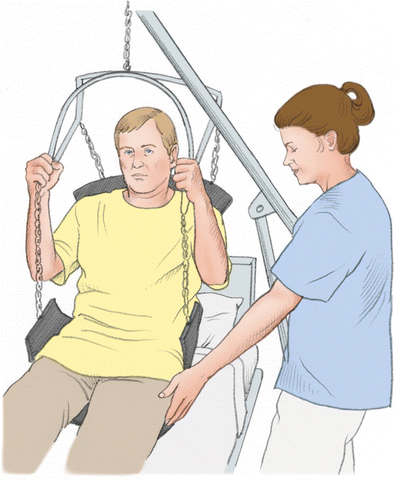
- After positioning the patient above the wheelchair, turn the lift handle counterclockwise to lower the patient onto the seat. When the chains become slack, stop turning and unhook the sling from the lift.
